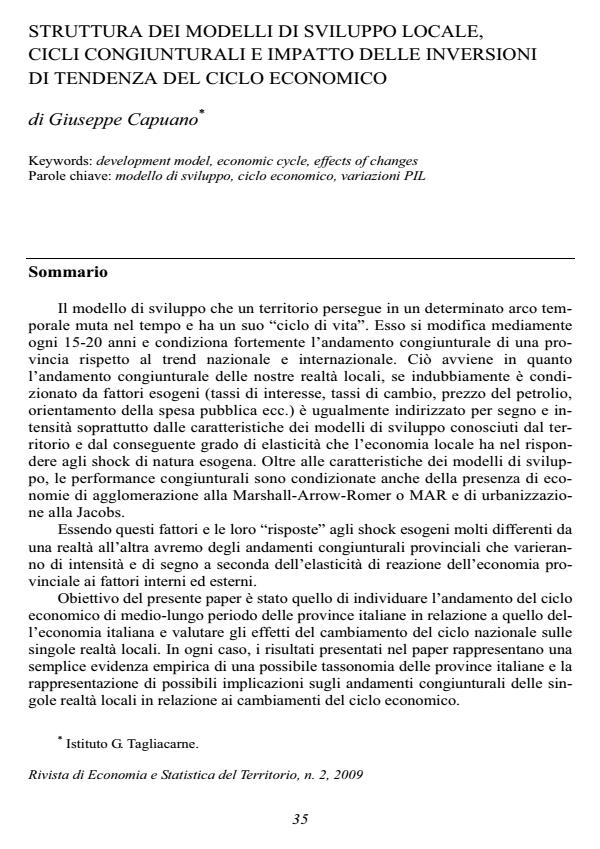Struttura dei modelli di sviluppo locale, cicli congiunturali e impatto delle inversioni di tendenza del ciclo economico
Journal title RIVISTA DI ECONOMIA E STATISTICA DEL TERRITORIO
Author/s Giuseppe Capuano
Publishing Year 2009 Issue 2009/2
Language Italian Pages 29 P. 35-63 File size 179 KB
DOI 10.3280/REST2009-002002
DOI is like a bar code for intellectual property: to have more infomation
click here
Below, you can see the article first page
If you want to buy this article in PDF format, you can do it, following the instructions to buy download credits

FrancoAngeli is member of Publishers International Linking Association, Inc (PILA), a not-for-profit association which run the CrossRef service enabling links to and from online scholarly content.
Structure of local development models, economic trends and impact of the economic cycle turnaround - The aim of this paper is to analyse the relationship between the intermediatelong term trend of the Italian provinces’ economic cycle and the national economy, and to evaluate the effects of changes in the national cycle on each local entity. The results shown in this paper present a simple empirical evidence of a possible taxonomy of Italian provinces, and the possible implications on the economic patterns of each local entity in connection with changes in the economic cycle. Methods and Results The study is based on the degrees of correlation between the variation rate of national and provincial GDP calculated between 1995 and 2006. Data on Italian provinces have been grouped into three clusters on the basis of the strength of the correlation. The development model that a territory follows, changes over a given period of time and it has its own "life cycle". This changes on average every 15-20 years and strongly influences the provincial economic pattern in relation to national and international trends. This happens because the economic pattern of our local entities, if indeed undoubtedly conditioned by exogenous factors (interest rates, exchange rates, price of petroleum, orientation of Government expenditure ecc.), is guided equally in character and strength above all by the development models’ characteristics which are known by the territory. It is also guided by the consequent degree of elasticity which the local economy shows in responding to exogenous shocks. In addition to development models’ characteristics, economic performance is conditioned by the presence of MAR and Jacobs economies. Conclusions Since local economic systems provide very different "answers" to shocks, we will have local trends which vary in intensity and character on the basis of the development model’s distinctive features and exogenous shocks.
JEL: B1, B41, E32, C6
Keywords: development model, economic cycle, effects of changes
Parole chiave: modello di sviluppo, ciclo economico, variazioni PIL
Giuseppe Capuano, Struttura dei modelli di sviluppo locale, cicli congiunturali e impatto delle inversioni di tendenza del ciclo economico in "RIVISTA DI ECONOMIA E STATISTICA DEL TERRITORIO" 2/2009, pp 35-63, DOI: 10.3280/REST2009-002002